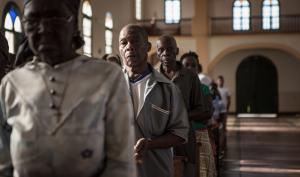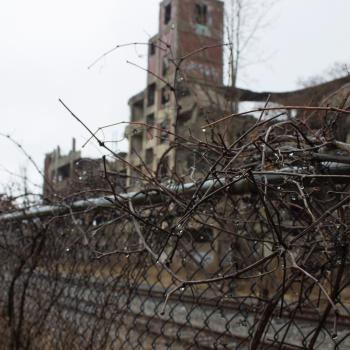 My memory of last summer is filled with Jesus. Jesus in many guises behind the glowing muslin scrim in the crypt confessionals: the varied inflections of his voice, the smell of his sweat or soap in the airless wooden cell.
My memory of last summer is filled with Jesus. Jesus in many guises behind the glowing muslin scrim in the crypt confessionals: the varied inflections of his voice, the smell of his sweat or soap in the airless wooden cell.
Sometimes I could tell he had eaten something spicy for lunch. Sometimes, by the source of his voice, I knew he was tall or stooped. Sometimes his wheeled walker was parked by the penitent’s kneeler, like the workaday incarnation of an accompanying angel. Once, he leaned a tall wooden walking staff outside the door.
It’s something of a joke among Washington DC’s Catholics that when you go to confession at the Basilica, you never know what you will get: a Jesus who is crotchety or gruff, or one with whom you will quarrel about whether or not a particular sin is a sin.
Down the street at the Holy Land Monastery, the more predictably pastoral Franciscans sit for confession on the hour, but if a penitent goes to them, she must be willing to confess face-to-face.
And last summer, I was not brave enough to look Jesus in the eyes every time I stumbled into confession to admit again and again that I had sinned.
Habitual sin is a great equalizer. One moment you are confident of your own character, certain that an old wound has been staunched by love. The next, you are picking and prodding that wound, refusing the Samaritan’s oil, pulling off each bandage for the perverse exhilaration of a bracing pain.
In that netherworld of insolence, I went to the Smithsonian’s Hirshhorn Museum and stood before the loop of an Ana Mendieta film as before an icon.
I watched again and again as she knelt naked beside a body-length silhouette swooped in the mud of an Iowa riverbank, set a rock in the place of the heart, anointed the rock with red paint as vivid as blood, and then nestled face-down into that silhouette: real heart beating against rock heart, like a wild rendering of Ezekiel’s promise that God will give hearts of flesh for hearts of stone.
Each loop of that film was for me like a beating of the breast, a cry to God that I knew what I was choosing was not life, but a semblance of death. Even as, with St. Paul, I did the evil I did not want to do, I longed to desire and do the right. And so almost every week, I went back to confession.
Confession, too, is a great equalizer. To wait in a quiet line with all manner of strangers, to go in to the confessional one-by-one, to sometimes hear those strangers’ tears or relieved laughter behind the wall, and to watch them emerge: wiping their eyes, striding freely, looking away to keep the privacy of healing in their hearts.
And then to enter in yourself and kneel before a glimmer of God in persona Christi, a man saddled with a great responsibility—one that may very well outpace his strength, outspan his shoulders.
He is summoning all his courage too, on the other side of the scrim. If he is a good man, he is humbled by the task. But even if he is not good, Jesus is there; he comes again in his distressing disguise of a fully mortal man.
Of all the priests of last summer, it is the priest with the wooden staff whose face I saw. Wearing a gray habit and a crazy sunhat, he careened into the staid crypt confessionals with a Krameresque entrance that made me stifle a laugh. But his entrance was nothing for his fiery, sober eyes.
It was a Saturday afternoon and the line was long, so I had to wait awhile before I passed his tall staff and entered his confessional.
If I read the shadows right, he still wore his sunhat. He blessed me; I confessed and cried. He spoke gently and firmly, his voice strong and untethered, as if he were accustomed to calling out in the wasteplaces—as if he had scoured the desert for me, sought me, and found me, so I could come up from wilderness leaning on him.
 Laura Bramon lives in Washington, DC, where she works on international child protection issues. Her creative work appears in The Best Creative Non-Fiction (W.W. Norton), Image, Books & Culture, Featherproof Press, and other outlets.
Laura Bramon lives in Washington, DC, where she works on international child protection issues. Her creative work appears in The Best Creative Non-Fiction (W.W. Norton), Image, Books & Culture, Featherproof Press, and other outlets.












